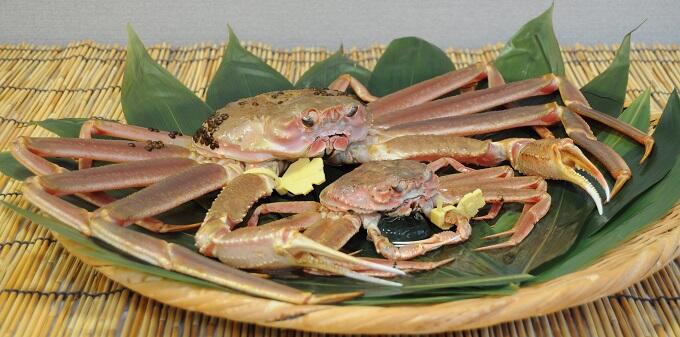Echizen Gani / Echizen Kani
| Registration Number | 69 |
|---|---|
| Name of the GI | Echizen Gani,Echizen Kani |
| Class | Fish and Shellfish |
| Date of Protection | 2018/09/27 |
| Producing Area | Fukui Prefecture |
| Applicant - Name and Address | Fukui Prefecture Fisheries Cooperative Associations 2-8-10 Ote, Fukui City, Fukui Prefecture, Japan |
Producing Area
Echizen Gani and Echizen Kani (hereinafter, Echizen Gani) is a snow crab caught by bottom trawling off the coast of Fukui Prefecture and the surrounding sea areas and landed in the ports of Fukui Prefecture.
The crabs are stored in a cool temperature immediately after catching until landing, resulting in the characteristics of fresh and high quality meat and richly flavored kanimiso(crab paste) (1) and uchiko (crab ovary), which can easily lose freshness.
Echizen Gani has been presented as a specialty by Fukui Prefecture to the Imperial House of Japan, for over 90 years and is well-recognized in Japan as an aquatic product representative of the prefecture, where the unit price per weight of snow crab is above the national average.
In regard to production method, Echizen Gani is caught by offshore bottom trawling or small boat bottom trawling off the coast of Fukui Prefecture and the surrounding sea areas (west of Noto Peninsula (2) in the Sea of Japan) and landed in the ports of Fukui Prefecture.
After being caught, the crabs are kept in fish tanks with seawater cooled by cooling systems or in fish boxes with ice bedding.
The shipping standard of Echizen Gani requires that male crabs must have shell the width of 9 cm or more, not including mizugani (freshly molted crabs with soft shells) and that female crabs be mature crabs that have laid eggs and carry them in their abdomen, excluding akako crabs carrying unfertilized, uneyed red eggs.
The sea west of Noto Peninsula in the Sea of Japan is inhabited by snow crabs, making it an important fishing area for Japan. In particular, the topography off the Echizen Coast (3) characterized by the sudden drop-off has contributed to establishing an ideal fishing area for snow crabs within a short distance from the coast, making Fukui Prefecture a traditionally well-known producer of snow crabs. The area has traditionally had many so-called discerning distributors with rich experience in snow crab trading, requiring the fishermen to consistently land snow crabs of sufficient quality to satisfy them. This has encouraged the fishermen to grade crabs and conduct cold storage for maintaining freshness onboard ships after catching.
Echizen Gani is shipped fresh to distributors, restaurants and hotels and retailed mainly as boiled snow crabs. They are highly valued for their high quality as a major local specialty of Fukui Prefecture.
- Kanimiso(Crab paste): The miso/paste-like substance found when taking the shell off crabs, this is an organ biologically referred to as hepatopancreas (digestive gland). It is a highly prized delicacy, and there are many enthusiastic fans of its unique flavor in Japan.
- Noto Peninsula: A peninsula that projects north into the Sea of Japan from the coast of central Hokuriku region, which has rich aquatic resources and is well-known production area of codfish, yellowtail and squid. The area is also rich in tourism resources such as the Wajima Morning Market, Wajima-nuri, scenic coastal landscapes including Rokkosaki, Sotoura and Uchiura, and Wakura hot spings.
- Echizen Coast: Refers to the coastline of the Sea of Japan centered around Echizen Cape in North-Central Fukui Prefecture, which is not a geographically distinct area. Comprising continuous coastal terraces formed through coastal uplift and rocky coast and cliff scenery formed by wave erosion, this area is also a tourist spot.


